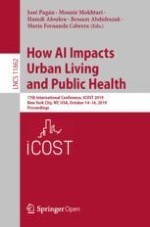Open Access 2019 | Open Access | Buch

How AI Impacts Urban Living and Public Health
17th International Conference, ICOST 2019, New York City, NY, USA, October 14-16, 2019, Proceedings
herausgegeben von: José Pagán, Mounir Mokhtari, Hamdi Aloulou, Prof. Bessam Abdulrazak, Prof. María Fernanda Cabrera
Verlag: Springer International Publishing
Buchreihe : Lecture Notes in Computer Science